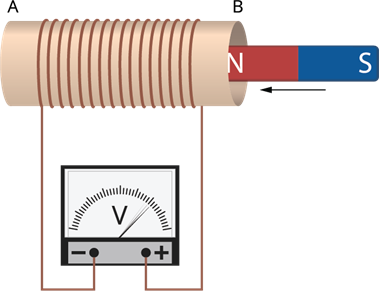
PUMPA - SMART LEARNING
எங்கள் ஆசிரியர்களுடன் 1-ஆன்-1 ஆலோசனை நேரத்தைப் பெறுங்கள். டாப்பர் ஆவதற்கு நாங்கள் பயிற்சி அளிப்போம்
Book Free DemoIn 1831, English physicist Michael Faraday first studied this; Faraday made a significant breakthrough by discovering how a moving magnet can be used to generate electric currents.
To observe this effect, let us perform the following activity.
To observe this effect, let us perform the following activity.
- Consider a coil of wire AB having a large number of turns.
- Connect the ends of the coil (AB) to a galvanometer, as shown in the below figure.

Moving magnet in a fixed conductor
- Take a strong bar magnet and move its north pole towards the end B of the coil.
Do you find any change in the galvanometer needle?
There is a in the needle of the galvanometer, .
This deflection shows the presence of a current in the coil AB. The deflection the moment the motion of the magnet stops.
- Now withdraw the north pole of the magnet away from the coil.
The galvanometer is deflected toward the , showing that the current is set up to the earlier deflection.
- Locate the magnet stationary at a point near the coil, maintaining its north pole towards the end B of the coil.
We can observe that the galvanometer needle deflects when the coil is moved towards the magnet's north pole. Similarly, the needle moves when the coil is moved away.
- When the coil is kept stationary with respect to the magnet, the deflection of the galvanometer .
What do you conclude from this activity?
You can also check that if you had moved the magnet's south pole towards the end B of the coil, the deflections in the galvanometer would just be to the previous case. When the coil and the magnet are both stationary, there is in the galvanometer.